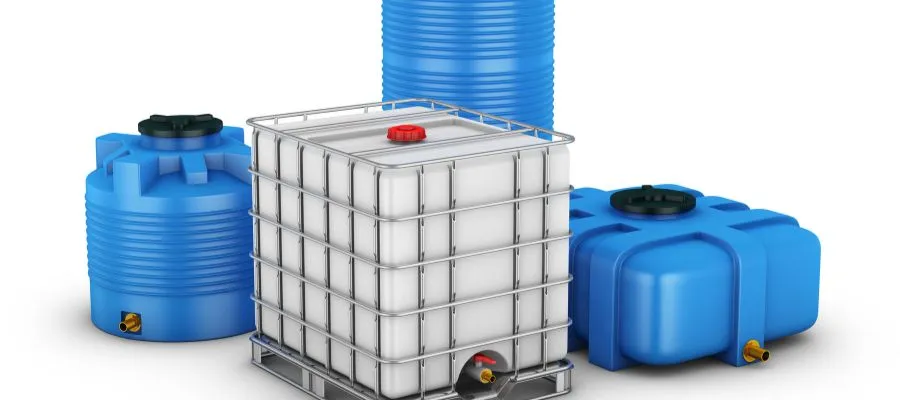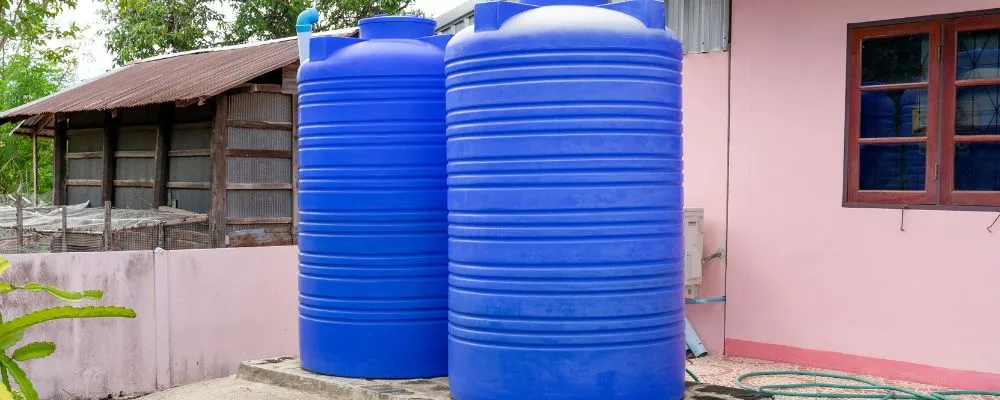Every house needs a reliable way to store water and keep it safe from dirt and debris for future use. A home water tank is a solution for storing and safeguarding water for future purposes. In this blog Brick & Bolt explains home water tanks, it’s important, and the different types of water tanks available for your home. This guide will help you make smart choices about storing water for your daily needs.
What is a Water Tank & Its’s Importanace?
A water tank is a large container used to store water. People can store water in these tanks for many reasons, such as drinking, farming, fire emergencies, and other domestic and commercial uses. For homeowners, having a home water tank is especially important to ensure a steady supply of water during droughts, water main breaks, and other emergencies that could stop their normal water service.
A home water tank is important for more reasons than just being ready for emergencies. In addition, it is very important to save water. When people collect and store rainwater, they use less municipal water supplies, which lowers their water bills and has less of an effect on the earth. A home water tank can also ensure that the water supply doesn’t run out during times of high demand, like when you’re farming or washing dishes.
Types of Home Water Tank

Each type of water tank has its own pros and cons. They come in different sizes, styles, and materials. The most popular types of water tanks for homes are bladder tanks, concrete tanks, steel tanks, and fibreglass tanks. Because each type is different, it can be used for different purposes and fit various preferences. Some of the home water tanks are-
- Plastic Water Tanks
- Steel Water Tanks
- Concrete Water Tanks
- Fibre Glass Water Tanks
- Bladder Water Tanks
1. Plastic Water Tanks
Polyethylene, a strong but lightweight plastic, is used to make plastic water tanks. People like these tanks because they are inexpensive and versatile.
Pros of Plastic Water Tanks
- Plastic tanks are usually less expensive than other types of tanks.
- They are easier to move and set up because they are light.
- Plastic tanks don’t rust, so they last longer.
- It can be set up in a lot of different ways to fit different needs and spaces.
Cons of Plastic Water Tanks
- Plastic tanks are strong, but they can crack more easily when they are hit or put under a heavy load.
2. Steel Water Tanks
Steel water tanks are made of galvanised or stainless steel and are a strong and long-lasting way to store water at home.
Types of Steel Water Tanks
Many types of steel tanks are on the market, but only two steel water tanks are mainly used in homes for storing water, and they are-
Corrugated Steel Tanks: These are made from ribbed steel sheets, making them stronger.
Welded Steel Tanks: Smooth-sided tanks that are made from welded steel plates are called welded steel tanks.
Pros of Steel Water Tanks
- Extremely long-lasting and able to handle extreme weather conditions.
- It can last for many years with proper maintenance.
- It is suitable for the storage of large amounts of water.
- The fact that steel tanks can be recycled makes them good for the environment.
Cons of Steel Water Tanks
- If you fail to maintain steel tanks properly, they can rust over time.
- In general, they cost more than plastic tanks.
- It is not easy to move and set up without professional help.
3. Concrete Water Tanks
Concrete water tanks are made of reinforced concrete and are known for being strong and lasting a long time.
Pros of Concrete Water Tanks
- Tanks made of concrete are very strong and can last for many years.
- They keep water warm in the winter and cool in the summer.
- It can be made in any shape or size, based on the water and space needs.
- Once they are set up, concrete tanks don’t need much upkeep.
Cons of Concrete Water Tanks
- Compared to other types of tanks, it costs more to buy or build at first.
- They are heavy, which makes them hard to move and set up.
- Concrete can get cracks over time, which can cause leaks.
4. Fibreglass Water Tanks
Reinforced fibreglass is used to make fibreglass water tanks. These tanks are strong for their weight and corrosion resistance.
Types of Fibre Glass Tanks
There are two types of fibreglass tanks commonly used in homes. They are
Above-Ground Fibreglass Tanks: These tanks are usually round and are made to be installed above ground.
Underground Fibreglass Tanks: These tanks are made to be buried, saving ground space and keeping the water from changing temperatures.
Pros of Fibreglass Water Tanks
- Fibreglass will not rust or corrode, no matter how challenging the climate is.
- It’s easier to move and set up than steel or concrete tanks.
- It doesn’t crack or break easily and lasts a long time.
- Doesn’t need as much maintenance as other materials.
Cons of Fibreglass Water Tanks
- Although fibreglass is strong and flexible, it can still crack in some situations.
- It is easy for algae to grow on fibreglass surfaces, especially when they are warm and humid.
5. Bladder Water Tanks
Bladder tanks, which are also called pillow tanks, are flexible containers made of strong, long-lasting materials that are meant to store water temporarily.
Pros of Bladder Water Tanks
- It’s easy to move and set up, making it perfect for emergency or temporary use.
- It can be taken down and put away when not in use.
- It can be used for many uses like storing water for drinking and watering plants.
Cons of Bladder Water Tanks
- It’s not the best way to store water for a long time.
- It may get hurt by sharp items or rough handling.
- Most of the time, they are smaller than regular water tanks.
What are the Factors to Consider When Choosing a Home Water Tank?
1. Before choosing a water tank, consider its primary purpose. Depending on the purpose, different types of tanks may be needed:
- A tank made of safe materials is needed to keep potable water.
- If there is a lot of water demand, you might need a bigger tank.
- The best tanks are ones that are made to collect and do rainwater harvesting.
- You need a tank that is strong and easy to handle for any emergency water storage.
2. Different materials are used to make water tanks, and each has pros and cons. So, know about them before purchasing tanks for homes.
3. The tank’s size and capacity are very important things to think about:
- For larger homes, bigger tanks are usually needed to hold enough water.
- Think about how much water you use every day for cooking, drinking, cleaning, and other activities.
- Check how much room there is for the tank to be installed, whether it’s above or below ground.
- You should plan for possible increases in water demand, like when you add more people to your family or grow your yard.
4. The place where you want to put the tank can affect your choice:
- It may take up more space, but above-ground tanks are easy to set up and keep up. Tanks that are buried save space on the ground and keep the water from freezing or flowing.
- Make sure the tank is easy to get for cleaning and upkeep.
- Some tanks, like steel and concrete ones, need a strong base to hold their weight.
5. Your home’s temperature and environment can affect how well and how long your water tank lasts:
- If you live in a place where temperatures change a lot, choose materials that don’t change much in temperature, like concrete or fibreglass.
- In places with strong sunlight, you need materials that don’t damage easily or tanks with protective coats.
- Consider tanks made to survive earthquakes if you live in an area that is prone to them.
6. Your budget will be a big part of your choice:
- Consider how much the tank will cost you upfront, including buying and installing it.
- Think about how much it will cost to maintain, fix, and replace the tank over its lifetime.
7. Make sure the tank you chose complies with the local regulations and standards :
- Try to know about local building codes and standards to see how to install a water tank.
- If you want to store drinking water in the tank, make sure it meets health and safety guidelines.
8. You can feel safe with a good guarantee and customer service:
- Look for tanks that come with long warranties that cover any problems or damage that might happen.
- Pick a manufacturer or provider with a good reputation and good customer service.
In conclusion, choosing the right water tank for your home is important to make sure that your family has a safe and reliable water source. Whether you choose a bladder tank, plastic, concrete, steel, fibreglass, or something else, each has its own pros and cons that you should think about based on your needs and situation. If people know about these differences, they can make smart choices that will help them store more water, support efforts to save water and give them peace of mind in case the water supply goes out. Buying a good home water tank isn’t just for ease; it’s also an important step toward being eco-friendly and ready for anything.
If you are planning to build your dream home but are worried about your budget estimation, use our cost estimator to estimate your budget. Then, construct your dream home with the best leading construction company in Chennai and make your dream come true.

